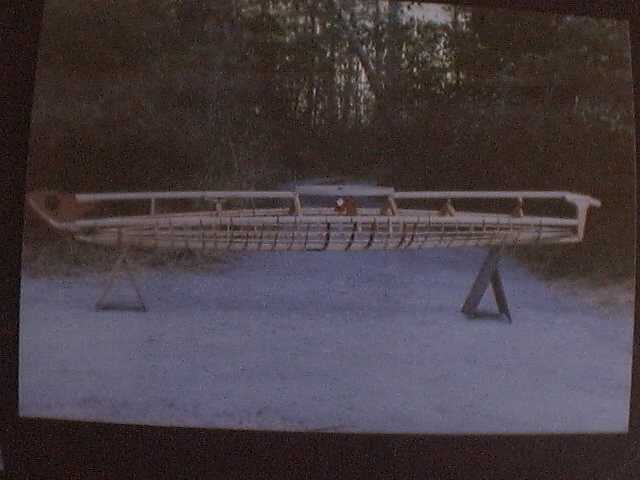Builder’s
Name |
Skip Snaith |
email |
kyak@rockisland.com |
Name and source
of boat design |
"Iluraq";
Modified Y-K Delta qayaq after Dick Bunyun(via Zimmerly's
"Hooper Bay Kayak Construction). |
Type of
construction and materials |
Skin-on-Frame.
|
Dimensions and
finished weight |
13' 4" LOA;
27" Beam; 14" Keel to deckridge, Midships. paddling weight, 32 lbs. |
Date of first
launch |
July, 1998 |
Height &
Weight of paddler |
5' 7", 165
lbs |
Typical paddling
conditions ( eg. Open ocean, flat river, white water river, etc) |
Ocean paddling,
also creeks, lakes, sloughs, just about anywhere. |

|
My
comments on the boat’s performance: (as applicable to particular design: stability,
speed, tracking, maneuverability, effects of wind and waves, load carrying capacity,
general "feel" and overall seaworthiness) |
Great boat, fast for it's size
and a real load hauler, good secondary stability when light but "lively" until
loaded. Much quicker and "sportier" than her dimensions (especially beam) would
suggest. Tracking is good due to straight keel and sharp ends, which is necessary because
they are customarily paddled with a single paddle, 2 strokes on one side, then switch.
It's a fun way to go, but I use a double blade for speed or distance. I made the
cockpit somewhat lower than an original might have and a double blade (even at 8' length)
works very well. I reduced the length to keep volume workable too, I'm not hauling seal
carcasses around too much these days. The deep cockpit keeps you dry and out of inclement
weather, Delta hunters would camp in their boats when they got weathered in. The single
paddle allows for "stealth" work and a wide variety of strokes. No drips either.
I've used it for day trips and camping in the San Juans, and am really impressed with the
Bering sea type, which many skinboat revivalists seem to think is too wide and deep. All I
can say is, try it, you'll like it. When paddling, you feel as if you were a large Eider
or Scaup duck, buoyant and salt-water adapted. |
My
comments on building the boat: (time, cost of materials, building tips, unusual
techniques, recommended reading, etc.) |
Longitudinals
are yellow cedar, Lower bow was a fir root, stern assembly made
up from straight grained yellow cedar stock. Some deck beams
are grown fir, others are half-lapped from yellow cedar. Ribs
are mainly willow, with about 5 "canoe style" oak
ribs midships. The upper bow is from 3/8 Bruynzeel plywood (first
use of PW in a skin boat for me, but a good application). Boat
is lashed with #12 seine twine, but I used a long bronze carriage
bolt to connect the lower bow, gunwale assembly. (Attention
purists- Delta eskimos use screws or nails here, and elsewhere
too). I used a long wedged-shaped gunwale block to connect the
gunwales fore and aft instead of the "ears" the Dick
Bunyun hewed into his. These are epoxy fastened. Covering is
8 0z nylon, with UA-75.
These boats are very different than the
Aleutian and Greenland types most builder are experienced with, so you may need to revamp
your thinking a bit. At times it's a real head scratcher. Zimmerly's text gives you what
you need. As mentioned above, there are some metal fasteners used, but not nearly as many
as qayaq builders from the 40's on up employed in the delta.
I also experimented with making some of the normally grown parts out of
straight-grained stock - Zimmerly shows this too, because some of these shapes are hard to
come by, and I also was thinking ahead to possible qayaq building projects in the Delta
with more modern materials. Several deck beams are half-lapped from 2x4's (yellow cedar),
which is a really good way to do it. The stern post is half-lapped too ( a sort of
"tee" section), and worked out well, although you need to think about how the
keel attaches at the bottom. A small grown knee seems to work pretty well. Glueing up the
lower bow assembly can be done but is less satisfactory than a grown piece if you can find
one. Plywood for the upper bow makes a lot of sense, the area of the hand hold is
delicate, and is broken on may old frames.
Deck rigging is essential on this boat, the traditional pattern of several straps
across the deck fore and aft, and an open loop at the stern is superior to modern x
patterns. Make a single paddle to go with the boat, or you will miss a lot of it's appeal.
The adz and crooked knife are really helpful tools when making this boat, more than
other types I've tried. Zimmerly's paper is out of print, but well worth tracking down if
you contemplate getting into this style of qayaq. |
|